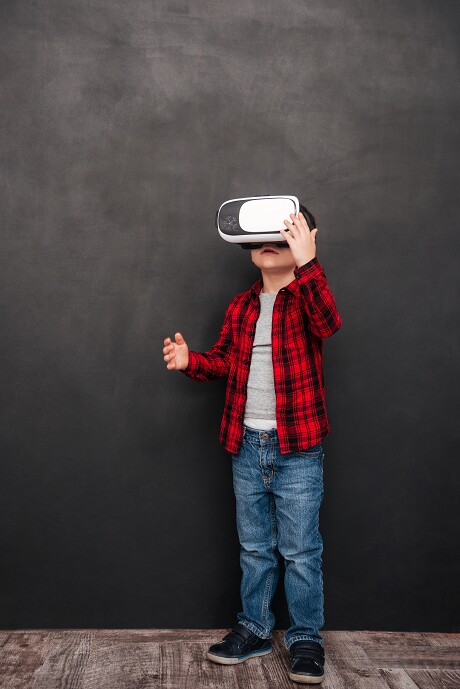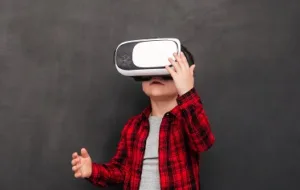“Can virtual-reality help close the achievement gap?” was the question urged at a presentation during this year’s ISTE conference.

 (The ISTE 2017 educational technology conference held in late June, with over 15,000 educators in attendance, is considered the largest ed-tech conference in the U.S. Every state and more than 72 countries were represented at this year’s ed-tech extravaganza.) For those not fluent in this topic, in the United States the “achievement gap” signifies the persistent gap we see in the academic performance levels of students of differing social economic status, race/ethnicity, and gender. In U.S. schools, the efforts to shrink this gap are relentless.
(The ISTE 2017 educational technology conference held in late June, with over 15,000 educators in attendance, is considered the largest ed-tech conference in the U.S. Every state and more than 72 countries were represented at this year’s ed-tech extravaganza.) For those not fluent in this topic, in the United States the “achievement gap” signifies the persistent gap we see in the academic performance levels of students of differing social economic status, race/ethnicity, and gender. In U.S. schools, the efforts to shrink this gap are relentless.
Presenting at the ISTE 2017 conference, Brian Seymour, Director of Instructional Technology with the Pickerington Local School District Ohio, campaigned passionately about reducing some of these disparities with the help of virtual reality. Seymour, recently named the Ohio IT IP Outstanding Technology Using Administrator for 2017, lamented that “educators around the world are looking for ways to close the achievement gap that exists between privileged students in disadvantaged students” and acted on the hunch that “virtual-reality [could do] a fantastic job of allowing students to have virtual experiences that they might not have otherwise.” This is his story, followed by some tempered insight.
Brian Seymour @ ISTE
Background
Seymour began by rolling out a two-part case study on using VR to reduce the achievement gap at Tussing Elementary, a diverse school where 58% of students receive free or reduced lunch and more than 25 languages are spoken at home. Their plan was to use VR within a three-week unit on oceans and marine animals.
Their case study was designed to meet a real educational problem head on. “For students in Ohio, going to the beach is no easy outing”, he explained. “Those with means can fly to the East or West Coast during summer vacation. But many will never see the ocean up close.” How this translates in the classroom is that the lack of experience with oceans for these landlocked students would ordinarily “leave students disengaged with the material.” With VR, however, they hoped to take students on a field trip to the beach, try a bit of snorkeling, and experience the inside of a shark cage.
Procedures
Using Viewmaster VR goggles, purchased in four classroom sets (28 goggles per set, at roughly $7000 per set), a core group of educators first learned how to use them and then matched up the best content possible in order to meet their unit learning objectives.
At first, students were taught traditionally for two weeks. When the first day of VR instruction arrived, the goggles were set up in the classroom while the kids were at lunch, and the app was loaded, and launched for use. The kids returned from lunch and recess and, after just 3 minutes of how-to instruction, the children were off exploring the ocean. (Yes, today’s students are that bright, able to learn what they need to know and proceed on their own in just minutes.)
Three adults facilitated the learning in the room, ensuring that students stay in their seats and not bump into each other. These educators also circulated around the room, asking questions and reminding the children kids to explore in all directions, not just what was in front of them.
In a second experience, the educators pursued a blended learning approach, having half of the students on the VR goggles, while the remaining children read a story related to their VR experience and then switched. This technique had only half of the students on the VR goggles at any one time. (Note that these classroom sets are a shared resource, travelling around the district.)
Findings
Three outcomes were notable:
- Before the VR experience, class conversations about the marine world were shallow and lacking, because the students had never been to the ocean before. After the treatment, class conversation lit up. Students were far more willing to share ideas and talk about the things they saw.
- According to Seymour, the 30 minute virtual trip seemed to have a lasting effect on most students. They constantly referred back to things they saw, heard or learned during their virtual trips.
- Overall, writing was more descriptive, vivid and detailed after the VR treatment.
Interestingly, these results are consistent with past research using stereoscopic 3D in classrooms, not just the more recent VR phenomenon. In fact, they are almost identical. None of these findings should surprise us, though. VR merely leverages the cognitive principles and advantages of visualization and ‘transfer’ of learning.
 Author Insights: The Idealism/Realism Tussle
Author Insights: The Idealism/Realism Tussle
The story I have related here is a fairly positive one. This school district is definitely on the right track toward addressing the achievement gap problem. But I routinely like to temper these feel-good anecdotes with just a dab of scrutiny. It’s part of my job—to be a “critical friend” of otherwise successful efforts at classroom innovation. As I read between the lines here are some key reservations that worry me:
- As was done so well in this case study, in order to be effective, VR must be inset within the curriculum and not stand on its own; these folks got it right. (I’m not so sure that is the case in many other school settings.)
- The cost described ($7000 for a classroom set) is simply and arguably unsustainable in today’s classrooms. Neither is it scalable. (Still, I love how Seymour’s team found a way to float a limited number of resources throughout the school district.)
- The presence of so many adult ‘guides’ (3) in a single classroom also forestalls true scalability and sustainability. (I realize it was their first time—so for now, the more, the merrier.)
- The expressed safety concerns (that students stay in their seats and not bump into each other), is a real problem; schools should pay attention to this problem.
Closing the achievement gap is a worthy goal for the use of VR in today’s classrooms. I encourage a more sound research paradigm for future case studies, however, in this way: let’s measure and report on the gains of disadvantaged students in relationship to more privileged students, so we know how big a difference we are actually making.—Len Scrogan

